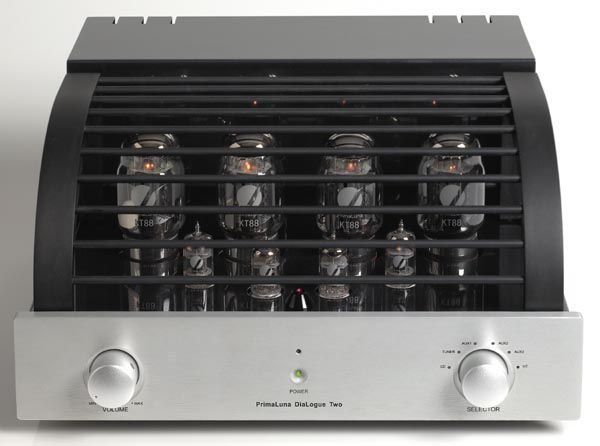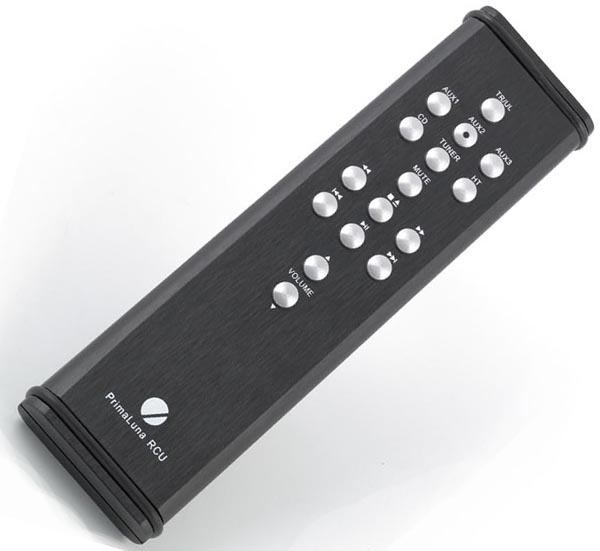PrimaLuna DiaLogue Two Integrated Tube Amplifier
| PrimaLuna DiaLogue Two Integrated Tube Amplifier |
| A Strong Case for Tubes |
|
|
|
June 2008 |

Okay, I admit it—I read Jim Hannon’s review of the PrimaLuna DiaLogue Two integrated tube amplifier in the October 2007 issue of The Absolute Sound magazine. And although I don’t lend automatic credence to any review I see in print, the review did get me interested enough to request a review sample and to see for myself whether or not all the PrimaLuna hype is justified.
Make no mistake; the DiaLogue Two is a thoroughly modern amplifier that includes a very hefty anodized aluminum remote control. It was designed in the Netherlands by Herman van den Dungen and is manufactured to stringent standards in China.
What we have here folks, is a 38-watt per channel integrated tube amplifier, that uses two Chinese KT88 per channel (patterned after the British Genalex KT88s) to develop its rated power into 8 ohms. One can switch from the 38-watt ultralinear mode via a push of the button on the remote, which cuts power down to 21 watts per channel triode. The input section uses two 12AX7 and two 12AU7 tubes.
From the get-go it was apparent that this was a very solid and well-built amplifier. Weighing in at a robust 64 pounds, with its oversized power and output transformers and thick aluminum faceplate, it certainly makes an impression the first time you have to lift it and carry it up a flight of stairs.
The heavy-gauge polished steel chassis is coated in a 5-step process with an automobile-grade dark blue paint. High quality parts are used throughout from the extra large half-speed wound output transformers to the ceramic tube sockets, Alps potentiometer, Nichicon and Solen capacitors, and WBT-style speaker terminals. Gold plated input jacks.

The DiaLogue Two is hand-made and point to point wired although it does contain a couple of internal printed circuit boards, one notably for the unique “Adaptive AutoBias” circuit, which is claimed to optimize valve performance and reduce distortion by 40 to 50%. It also extends tube life and makes the unit more reliable and user-friendly.
Here’s the cool thing about the Adaptive AutoBias – almost any output tube can be plugged in and played. This unique biasing circuit will sense the tube type and automatically set the bias for optimal operation. You don’t need to do anything other than install your favorite tubes, then sit back and enjoy! In addition to KT88s, the amp can use 6550, KT90, EL-34, KT77, 6CA7, 6L6GC, KT66, 7581, and 6V6GT tubes, or any of their equivalents. Talk about a tube-roller’s paradise!
Features:
The DiaLogue Two has a rotary volume control and six switched inputs, which include a HT input that bypasses the volume control and the tube input section. Therefore, when using the HT input, the source must have its own volume control if you don’t intend the DiaLogue Two to play into your speakers and ears at FULL VOLUME!
One very nice extra cost option is the installation of a very articulate and musical MM phono stage (more on this later). The $199 extra was installed on my review sample on AUX 2. The rocker off/on switch is on the front left side of the chassis and is not controlled by the remote control.
The rear panel contains 6 pairs of gold-plated RCA inputs and one pair of RCA tape outputs plus a grounding post. There are WBT style speaker posts for 4 or 8 ohms, and an IEC AC receptacle to facilitate after-market power cords (I found the stock cord to sound very respectable). The DiaLogue Two contains internal AC and plate fuses, and a few spare fuses are included in the package, as are a pair of white handling gloves.
The remote is an attractive black-anodized heavy-metal unit that is quite useful. In addition to the usual volume control, you can choose inputs, mute and un-mute, and switch from ultralinear to triode operation at the push of a button. It appears to have other transport control buttons that will conveniently operate the PrimaLuna CD player. The remote has rubber rings installed at each end so that it won’t scratch your furniture. Nice touch.
I did some experimenting with the ultralinear to triode switching and found the triode mode to be generally a bit warmer and slightly sweeter sounding. It seemed to work well for low level listening and for acoustic singer/songwriter music. The ultralinear mode was used for most of my evaluation because it provides greater power and better articulation at the frequency extremes.
Notes on Impedance and Tube-Rolling:
The first thing one needs to determine when installing the DiaLogue Two in a system, is whether to use the 4-ohm or 8-ohm speaker posts. This would seem perfectly straight forward, but in my experience it was not exactly the case.
Since my Silverline Prelude speakers have a nominal 8-ohm rating, I started with the 8-ohm taps. In that configuration, the DiaLogue Two sounded very matter-of-fact and very similar to many solid-state amplifiers. The sound was clean and extended at the frequency extremes, but the harmonic sweetness I had expected to hear from the DiaLogue Two was somehow missing in action.
![]()
Don’t forget to bookmark us! (CTRL-SHFT-D)
Stereo Times Masthead
Publisher/Founder
Clement Perry
Editor
Dave Thomas
Senior Editors
Frank Alles, Mike Girardi, Russell Lichter, Terry London, Moreno Mitchell, Paul Szabady, Bill Wells, Mike Wright, and Stephen Yan,
Current Contributors
David Abramson, Tim Barrall, Dave Allison, Ron Cook, Lewis Dardick, John Hoffman, Dan Secula, Don Shaulis, Greg Simmons, Eric Teh, Greg Voth, Richard Willie, Ed Van Winkle, Rob Dockery, Richard Doran, and Daveed Turek
Site Management Clement Perry
Ad Designer: Martin Perry






Be the first to comment on: PrimaLuna DiaLogue Two Integrated Tube Amplifier